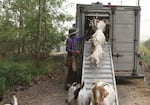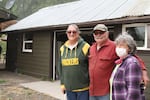
It took two-and-a-half minutes to get 230 goats out of one trailer. They'll spend the next week eating the undergrowth of a grove of trees in Forest Grove.
Kristian Foden-Vencil
With thousands of Oregonians forced from their homes and dozens of wildfires burning, reasons for optimism in the state may seem elusive.
But one small example can be found in Forest Grove: a herd of 230 fire-preventing goats.
For the next week, they’ll be eating the dry undergrowth in a 14-acre grove that someday may be a city park.
“It’s something to see,” Leslie Lundquist said recently as she watched the goats jump out of a trailer like so many clowns from a clown car.
“Away they go!” she said. “And they’re all different sizes and colors. Fun to watch.”
Forest ecologists and wildfire experts have pointed to excess vegetation and undergrowth, often near power lines or among standing timber, as a key potential fuel source for catastrophic wildfires. Removing or reducing those fuels is seen as one way to help reduce the risk or at least minimize the potential spread.
In some places, that means goats.
Related: How to prepare your home for wildfire
These belong to Healing Hooves, an eastern Washington company that takes the goats across the Northwest at the request of cities and private land owners.
The goats cost about $800 a day, plus a trucking fee, so potentially quite less than the cost of power tools and city employees. The animals are corralled within an electric fence, which moves with them as they eat.

Goats are renowned for eating almost anything, "They won't eat a tin can," said shepherd Craig Madsen, "but they will eat the label."
Kristian Foden-Vencil
“People say: ‘Oh, what do you do?’" said their caretaker, Craig Madsen. ‘"I’m a shepherd.’ You get this second look.”
Madsen is used to that double take. He’s been a shepherd for 18 years, ever since giving up an office job with the federal government.
From May to October he drives his herd from one spot to another, living in the back of his truck with little more than a bed. His wife chooses to stay at home.
“This is kind of more of an urban site," he said of Forest Grove this week. “There are people doing it out on the range. They’re out there managing weeds in that kind of environment.
"I get a lot of requests from people who want to do their backyards. And I say: ‘I don’t do those, because I can’t put 230 goats in your backyard.’ But there are people who’ll have a dozen or so goats. They’ll come out and do those projects.”

Shepherd Craig Madsen puts up an electric fence so his 230 goats will eat everything on the right property.
Kristian Foden-Vencil
Madsen’s main job is to move the fences and to keep the goats inside. They like to climb, and sometimes the best thing to climb is a shiny new car.
Madsen said the job can be lonely, but he likes to read, and he has two canine companions: Gigi, an Irish wolf hound who spends the night keeping away coyotes (even cougars in some regions), and Nessie, a herding dog who will corral the goats back into the trailer when it’s time to move to greener pastures.
Their next stop: Spokane.
“I’ll be doing some work in the city of Spokane, and the primary purpose is to reduce fuel loads. And second is to try and manage noxious weeds,” Madsen said.
He estimates his flock can clear an acre in about a day and a half.

Neighbors of the 14-acre parcel of land have come together to watch the goats unload.
Kristian Foden-Vencil
Mary and Mean Bolden live next to the swath of land the goats are clearing. They know Craig Madsen from last year, and they want him to feel at home.
“He knows where the water is. He charges the batteries for his fence,” said Mean Bolden. “We let him come over and take a shower and wash his clothes."
“We have a spare bed," said Mary Bolden, who even made Madsen an apple pie. "But he won’t stay in that.”
So the thousands of people fighting fires across Oregon, Washington and California can take some solace knowing that there’s a small army of goats, also doing their part to suppress fire.

230 goats are expected to clear one acre of undergrowth every one-and-a-half days.
Kristian Foden-Vencil

